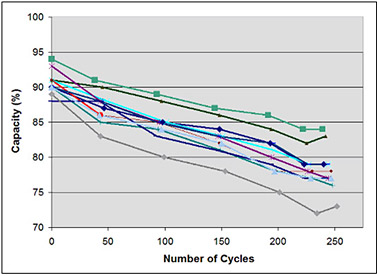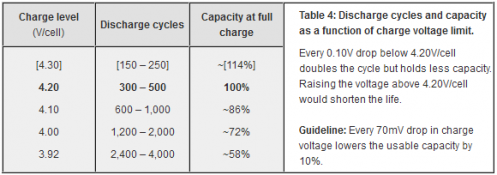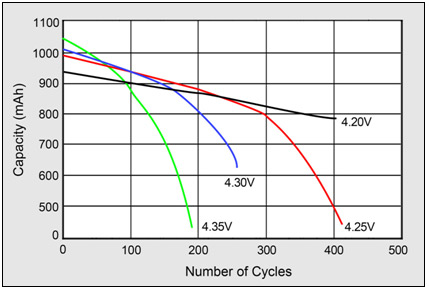

BU-808: How to Prolong Lithium-based Batteries
Discover what causes Li-ion to age and what the battery user can do to prolong its life.
Battery research is focusing on lithium chemistries so much that one could imagine that the battery future lies solely in lithium. There are good reasons to be optimistic as lithium-ion is, in many ways, superior to other chemistries. Applications are growing and are encroaching into markets that previously were solidly held by lead acid, such as standby and load leveling. Many satellites are also powered by Li-ion.
Lithium-ion has not yet fully matured and is still improving. Notable advancements have been made in longevity and safety while the capacity is increasing incrementally. Today, Li-ion meets the expectations of most consumer devices but applications for the EV need further development before this power source will become the accepted norm.
What Causes Lithium-ion to Age?
The lithium-ion battery works on ion movement between the positive and negative electrodes. In theory such a mechanism should work forever, but cycling, elevated temperature and aging decrease the performance over time. Manufacturers take a conservative approach and specify the life of Li-ion in most consumer products as being between 300 and 500 discharge/charge cycles.
Evaluating battery life on counting cycles is not conclusive because a discharge may vary in depth and there are no clearly defined standards of what constitutes a cycle (see BU-501: Basics About Discharging). In lieu of cycle count, some device manufacturers suggest battery replacement on a date-stamp, but this method does not take usage into account. A battery may fail within the allotted time due to heavy use or unfavorable temperature conditions; however, most packs last considerably longer than what the stamp indicates.
The performance of a battery is measured in capacity, a leading health indicator. Internal resistance and self-discharge also play roles, but these are less significant in predicting the end of battery life with modern Li-ion.
Figure 1 illustrates the capacity drop of 11 Li-polymer batteries that have been cycled at a Cadex laboratory. The 1,500mAh pouch cells for mobile phones were first charged at a current of 1,500mA (1C) to 4.20V/cell and then allowed to saturate to 0.05C (75mA) as part of the full charge saturation. The batteries were then discharged at 1,500mA to 3.0V/cell, and the cycle was repeated. The expected capacity loss of Li-ion batteries was uniform over the delivered 250 cycles and the batteries performed as expected.

Figure 1: Capacity drop as part of cycling.
Eleven new Li-ion were tested on a Cadex C7400 battery analyzer. All packs started at a capacity of 88–94% and decreased to 73–84% after 250 full discharge cycles. The 1500mAh pouch packs are used in mobile phones.
Courtesy of Cadex
Although a battery should deliver 100 percent capacity during the first year of service, it is common to see lower than specified capacities, and shelf life may contribute to this loss. In addition, manufacturers tend to overrate their batteries, knowing that very few users will do spot-checks and complain if low. Not having to match single cells in mobile phones and tablets, as is required in multi-cell packs, opens the floodgates for a much broader performance acceptance. Cells with lower capacities may slip through cracks without the consumer knowing.
Similar to a mechanical device that wears out faster with heavy use, the depth of discharge (DoD) determines the cycle count of the battery. The smaller the discharge (low DoD), the longer the battery will last. If at all possible, avoid full discharges and charge the battery more often between uses. Partial discharge on Li-ion is fine. There is no memory and the battery does not need periodic full discharge cycles to prolong life. The exception may be a periodic calibration of the fuel gauge on a smart battery or intelligent device. (See BU-701a: How to Calibrate Batteries)
Table 2 compares the number of discharge/charge cycles Li-ion can deliver at various DoD levels before the battery capacity drops to 70 percent. All other variables such as charge voltage, temperature and load currents are set to average default settings.

Lithium-ion suffers from stress when exposed to heat, so does keeping a cell at a high charge voltage. A battery dwelling above 30°C (86°F) is considered elevated temperature and for most Li-ion a voltage above 4.10V/cell is deemed as high voltage. Exposing the battery to high temperature and dwelling in a full state-of-charge for an extended time can be more stressful than cycling. Table 3 demonstrates capacity loss as a function of temperature and SoC.

Most Li-ions charge to 4.20V/cell, and every reduction in peak charge voltage of 0.10V/cell is said to double the cycle life. For example, a lithium-ion cell charged to 4.20V/cell typically delivers 300–500 cycles. If charged to only 4.10V/cell, the life can be prolonged to 600–1,000 cycles; 4.0V/cell should deliver 1,200–2,000 and 3.90V/cell should provide 2,400–4,000 cycles.
On the negative side, a lower peak charge voltage reduces the capacity the battery stores. As a simple guideline, every 70mV reduction in charge voltage lowers the overall capacity by 10 percent. Applying the peak charge voltage on a subsequent charge will restore the full capacity.
In terms of longevity, the optimal charge voltage is 3.92V/cell. Battery experts believe that this threshold eliminates all voltage-related stresses; going lower may not gain further benefits but induce other symptoms. (See BU-808b: What causes Li-ion to die?) Table 4 summarizes the capacity as a function of charge levels. (All values are estimated; Energy Cells with higher voltage thresholds may deviate.)

Most chargers for mobile phones, laptops, tablets and digital cameras charge Li-ion to 4.20V/cell. This allows maximum capacity, because the consumer wants nothing less than optimal runtime. Industry, on the other hand, is more concerned about longevity and may choose lower voltage thresholds. Satellites and electric vehicles are such examples.
For safety reasons, many lithium-ions cannot exceed 4.20V/cell. (Some NMC are the exception.) While a higher voltage boosts capacity, exceeding the voltage shortens service life and compromises safety. Figure 5 demonstrates cycle count as a function of charge voltage. At 4.35V, the cycle count of a regular Li-ion is cut in half.

Figure 5: Effects on cycle life at elevated charge voltages.
Higher charge voltages boost capacity but lowers cycle life and compromises safety.
Source: Choi et al. (2002)
Besides selecting the best-suited voltage thresholds for a given application, a regular Li-ion should not remain at the high-voltage ceiling of 4.20V/cell for an extended time. The Li-ion charger turns off the charge current and the battery voltage reverts to a more natural level. This is like relaxing the muscles after a strenuous exercise. (See BU-409: Charging Lithium-ion)
What can the User Do?
Environmental conditions, not cycling alone, govern the longevity of lithium-ion batteries. The worst situation is keeping a fully charged battery at elevated temperatures. Battery packs do not die suddenly, but the runtime gradually shortens as the capacity fades.
Lower charge voltages prolong battery life and electric vehicles and satellites take advantage of this. Similar provisions could also be made for consumer devices, but these are seldom offered; planned obsolescence takes care of this.
A laptop battery could be prolonged by lowering the charge voltage when connected to the AC grid. To make this feature user-friendly, a device should feature a “Long Life” mode that keeps the battery at 4.05V/cell and offers a capacity of about 80 percent. One hour before traveling, the user requests the “Full Capacity” mode to bring the charge to 4.20V/cell.
The question is asked, “Should I disconnect my laptop from the power grid when not in use?” Under normal circumstances this should not be necessary because charging stops when the Li-ion battery is full. A topping charge is only applied when the battery voltage drops to a certain level. Most users do not remove the AC power, and this practice is safe.
Modern laptops run cooler than older models and reported fires are fewer. Always keep the airflow unobstructed when running electric devices with air-cooling on a bed or pillow. A cool laptop extends battery life and safeguards the internal components. Energy Cells, which most consumer products have, should be charged at 1C or less. Avoid so-called ultra-fast chargers that claim to fully charge Li-ion in less than one hour.
Last updated 2016-03-07
source: http://batteryuniversity.com/learn/article/how_to_prolong_lithium_based_batteries




